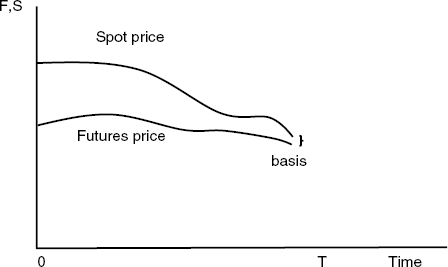The Relationship between Spot Prices and Forward (Futures) Prices
Suppose we buy one unit of the commodity at price S on the spot market and simultaneously enter a forward contract to deliver at time T one unit at price F (that is, we short one unit). We store the commodity for a period T and deliver it at price F. The cash flow is (–S,F) which is fully determined at t = 0. This cash flow must be fully consistent with the interest rate over that period. Here's why.
Let's let d(0,T) represent the discount rate over the period of the contract. That is d(0,T) = (1 + r)−T where, typically, r is the annual risk-free interest rate. Buying the commodity for future resale at price F must be exactly the same as lending an amount S with ending value equal to S/d(0,T). This implies that S = F d(0,T), which is the discounted value of the future payment for the time in question. Thus, the contract is priced so that it has zero value relative to a loan S at the market rate of interest.
If F > S/d(0,T), then an arbitrage profit could be earned by shorting the contract. We could borrow S right now to buy the asset and deliver it at time T for F, keeping F – S/d(0,T). That is, if the future value is higher than what you could earn if you were to invest S at 1/d(0,T), then you'd want to receive F later, at time T. To receive F, you store the asset. If, on the other hand, F < S/d(0,T), then clearly it would pay to short the asset and use the proceeds to invest at 1/d(0,T). At the same time, we'd go long in the forward contract, agreeing now to purchase the asset at T for F and keeping the difference.
This logic suggests that as the delivery date nears, the forward price F and the spot price S must converge. The reason is that 1/d(0,T) must converge to one as T converges to zero. This is illustrated in Figure 15.1. Stated differently, the cash flow (–S,F) must be fully consistent with the existing term structure of interest rates, or else investors will exploit arbitrage opportunities by borrowing and lending at the market rate, either storing the asset for future delivery or shorting the asset, investing the proceeds and taking delivery of the asset for a price less than the value of the investment.
Thus, while at t = 0, F(t) and S(t) may be quite different, but as t →T, these two quantities must converge. The only reason they would not is because either the hedged asset is not the same as the asset used to hedge in the futures market, for example, we hedge our $/euro exposure using forward contracts on yen, or that the futures contract may need to be closed out before the delivery month. The difference F(t) – S(t) is referred to as the basis, and a nonzero basis is a risk, as we shall shortly demonstrate. The diagram shows S(t) > F(t), but it is understood that S(t) < F(t) may hold as well.
Figure 15.1 Basis Risk

